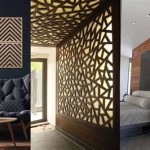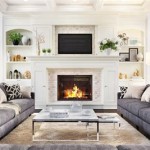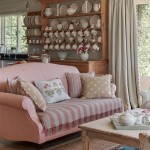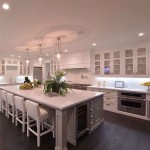How To Decorate a Room With Dark Green Walls
Dark green walls offer a sophisticated and impactful design choice, capable of transforming a room into a luxurious and inviting space. They evoke a sense of nature, depth, and drama, setting the stage for a unique decorating experience. However, successfully decorating a room with dark green walls requires careful consideration of color palettes, lighting strategies, and furniture selection. This article provides a comprehensive guide to navigate the nuances of decorating with this bold color, ensuring a harmonious and visually appealing result.
Understanding the Undertones of Dark Green
The first step in decorating with dark green is to identify the specific undertones present in the chosen paint color. Dark greens can lean towards a range of hues, including blue, yellow, or brown. Recognizing these undertones is crucial for selecting complementary colors and avoiding clashing palettes. Greens with blue undertones, such as forest green or hunter green, evoke coolness and serenity, pairing well with silvery accents and cool-toned neutrals. Conversely, greens with yellow undertones, like olive green or chartreuse-tinged dark greens, offer warmth and vibrancy, blending seamlessly with golden accents and earthy hues. Greens with brown undertones, akin to moss green or deep sage, create a grounding and organic feel, working effectively with natural materials and warm neutrals. Examining paint swatches under different lighting conditions is crucial for accurate undertone assessment.
Once the undertones are identified, this knowledge can then inform the selection of complementary colors for furniture, accessories, and artwork. Misjudging the undertones can lead to a discordant color scheme, undermining the desired aesthetic. For instance, pairing a warm-toned red with a blue-undertoned green could result in a visually jarring contrast. Instead, opt for analogous color schemes, such as pairing a blue-undertoned green with shades of teal or turquoise, or complementing a yellow-undertoned green with mustard yellow or ochre.
Optimizing Lighting for Dark Green Walls
Dark green walls significantly impact the overall brightness of a room. They absorb a substantial amount of light, requiring a strategic approach to lighting to prevent the space from feeling gloomy or cramped. Implementing a multi-layered lighting scheme is essential. This involves combining ambient, task, and accent lighting to illuminate the room effectively.
Ambient lighting, typically provided by overhead fixtures like chandeliers or recessed lights, establishes the overall brightness of the room. For a room with dark green walls, it is advisable to choose fixtures with a higher lumen output to compensate for the light absorption. Integrating dimmer switches allows for adjustable brightness levels, catering to different needs and moods. Task lighting, such as table lamps or floor lamps, focuses light on specific areas, enhancing visibility for activities like reading or working. Placing task lamps strategically on desks, side tables, or near armchairs improves functionality and adds visual interest. Accent lighting, including spotlights or picture lights, highlights artwork, architectural features, or decorative objects. This adds depth and dimension to the room, preventing the dark green walls from appearing flat. Positioning accent lights to bounce light off reflective surfaces, like mirrors or metallic accents, can further enhance the overall brightness.
Beyond the type of lighting, the color temperature of the light bulbs also plays a significant role. Warm white light bulbs (2700-3000K) create a cozy and inviting atmosphere, complementing the richness of dark green walls. Cool white light bulbs (3500-4100K) provide a brighter, more energizing light, suitable for task-oriented spaces. Experimenting with different color temperatures allows for customizing the ambiance to suit individual preferences and the intended use of the room.
Selecting Furniture and Accessories That Complement Dark Green
Furniture and accessory choices are paramount in creating a cohesive and balanced design in a room with dark green walls. The key is to select pieces that complement the depth and richness of the walls, preventing the space from feeling overwhelming or visually cluttered.
Consider contrasting textures and materials to add visual interest. Pairing smooth velvet upholstery with rough-hewn wooden accents, or juxtaposing sleek metal furniture with woven rugs, creates a dynamic and tactile experience. Incorporating natural materials, such as wood, leather, and stone, enhances the organic feel of the dark green walls. Wooden furniture in warm tones, like walnut or oak, adds warmth and richness, while leather upholstery in shades of brown or tan provides a classic and sophisticated touch. Stone accents, like marble countertops or slate floors, introduce a touch of luxury and grounding.
When it comes to color palettes, opt for complementary or contrasting hues that enhance the dark green walls. Neutral colors, such as white, cream, beige, and gray, provide a calming and sophisticated backdrop, allowing the dark green walls to take center stage. Pops of color, such as gold, mustard yellow, blush pink, or deep burgundy, add vibrancy and personality. Metallic accents, like brass, gold, or silver, introduce a touch of glamour and reflect light, enhancing the overall brightness. Artwork plays a crucial role in complementing dark green walls. Opt for pieces with contrasting colors or textures to create visual interest. Landscape paintings, abstract art with bold colors, or black and white photography can beautifully complement the dark green backdrop.
Furthermore, consider the scale of the furniture in relation to the size of the room. Avoid overcrowding the space with bulky furniture, as this can make the room feel smaller and more cramped. Opt for streamlined furniture pieces with clean lines to create a sense of spaciousness. Mirrors are invaluable for reflecting light and creating the illusion of more space. Placing a large mirror on a wall opposite a window or near a light source can significantly enhance the brightness and openness of the room. Incorporating plants adds a touch of nature and freshness to the space. Green plants, such as ferns, snake plants, or philodendrons, complement the dark green walls and enhance the overall organic feel. Consider the size and placement of plants to ensure they don't obstruct natural light or overcrowd the space.
Creating Focal Points and Visual Interest
A successfully decorated room features focal points that draw the eye and create visual interest. With dark green walls providing a dramatic backdrop, establishing focal points becomes even more crucial to prevent the space from feeling monotonous. A focal point can be a striking piece of furniture, a captivating artwork, a unique architectural feature, or even a well-styled vignette. Selecting a focal point aligned with the room's purpose and style is crucial for a cohesive design.
For instance, in a living room with dark green walls, a fireplace could serve as a natural focal point. Highlighting the fireplace with decorative elements, such as an ornate mantel, a decorative mirror above, or strategically placed lighting, draws attention and creates a warm and inviting atmosphere. Alternatively, a large-scale artwork hung above a sofa or console table can serve as a focal point, adding color, texture, and personality to the room. In a bedroom with dark green walls, the bed can be transformed into a focal point with a luxurious headboard, plush bedding, and artfully arranged pillows. Adding a statement chandelier or pendant light above the bed can further enhance its visual impact.
Creating a vignette on a console table, bookshelf, or mantelpiece offers another avenue for establishing visual interest. A vignette is a curated arrangement of objects that tells a story or creates a specific mood. Incorporating items with varying heights, textures, and colors adds depth and dimension to the vignette. Consider including items like books, candles, vases, picture frames, and small sculptures. Varying the height of the objects within the vignette creates visual interest. Place taller items at the back and shorter items at the front, allowing each object to be visible. Overlapping objects slightly adds depth and creates a sense of cohesion.
Adding elements of surprise and whimsy can also enhance visual interest. Introducing unexpected colors, patterns, or textures can inject personality and prevent the room from feeling too predictable. Consider incorporating a bold statement rug, a collection of vintage curiosities, or a vibrant piece of artwork. The key is to balance these elements with the overall design scheme, ensuring they complement rather than clash with the dark green walls.
Ultimately, decorating a room with dark green walls is about creating a harmonious and balanced space that reflects individual style and preferences. By carefully considering color palettes, lighting strategies, furniture selections, and focal points, a room can be transformed into a luxurious, inviting, and visually captivating environment.

My Green Living Room With Dark Paint Bigger Than The Three Of Us

My Green Living Room With Dark Paint Bigger Than The Three Of Us


Dark Green Design Dreamy Rooms Spaces Firefly Finch Living Room New Bedroom Plants

Dark Green Design Dreamy Rooms Spaces Firefly Finch

Dark Green Bedroom Ideas Decorating Design Corral Room Walls Decor

My Green Living Room With Dark Paint Bigger Than The Three Of Us

Green Living Room Ideas For A Restful And Comfortable Space Mylands

Everything About The Green Accent Wall And Why You Want One Homilo

How To Decorate A Green Accent Wall In The Bedroom Grace My Space
Related Posts







